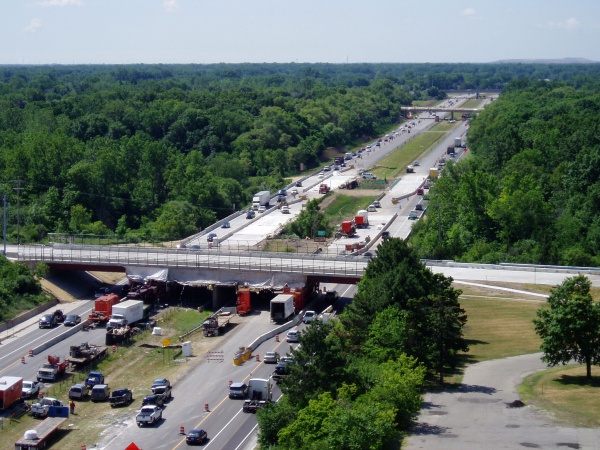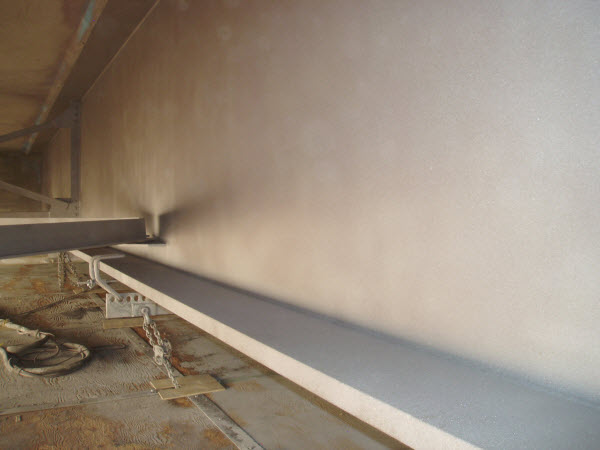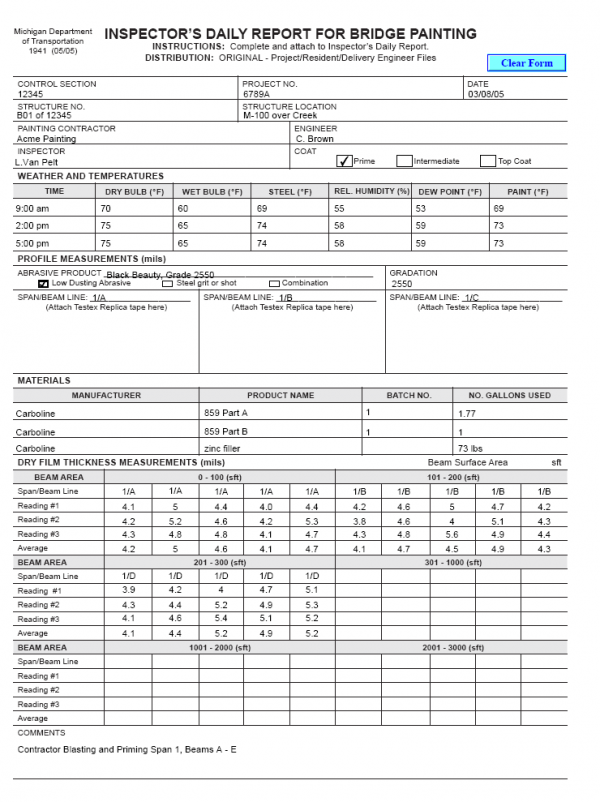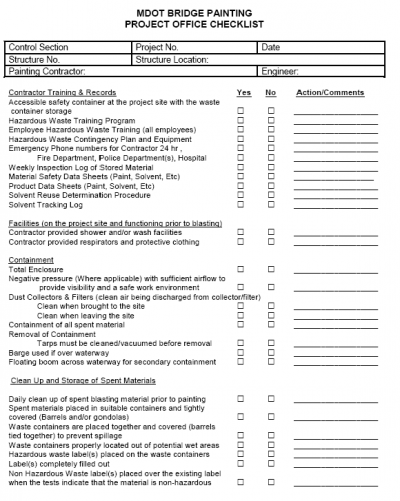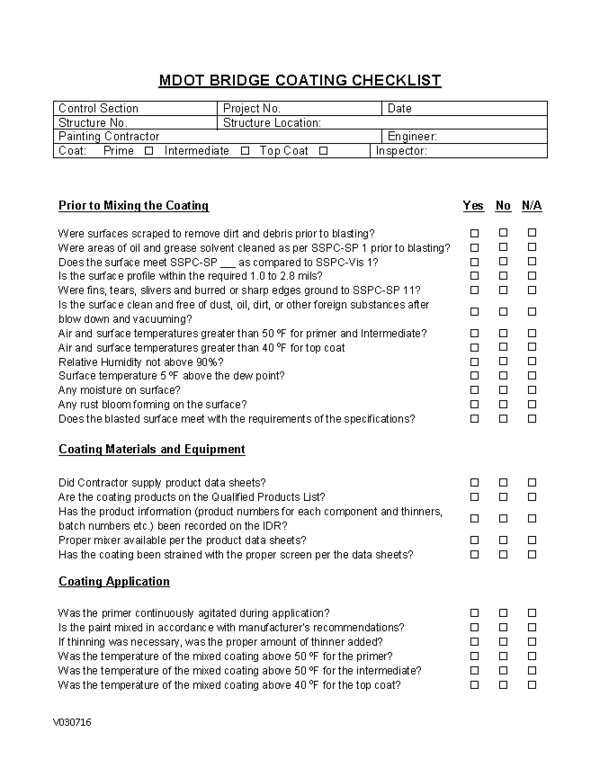Difference between revisions of "715 - Cleaning and Coating Existing Structural Steel"
m (→Requirements: Fixed broken link for QPL) |
m (Updated content related to: Health and Safety, Respiratory Protection and Protective Equipment, Medical Surveillance, Exposure Monitoring, Hygiene Facilities, and Lead Awareness Training) |
||
| Line 16: | Line 16: | ||
The Contractor will provide the equipment and the training necessary to insure the safety of the personnel that are required to do the work and inspection required for the removal of lead-based coatings from existing structural steel bridges. | The Contractor will provide the equipment and the training necessary to insure the safety of the personnel that are required to do the work and inspection required for the removal of lead-based coatings from existing structural steel bridges. | ||
| − | + | ||
| − | The equipment and the training will, | + | The equipment and the training will, at a minimum, provide employees with respirators including fit testing, respirator training and a respirator program. Protective clothing and equipment, change areas, showers, eating facilities and hand washing facilities are also required. |
| − | + | ||
| − | All bridge painting inspectors and the Resident/Project/Delivery Engineers must be familiar with [http://www.michigan.gov/documents/CIS_WSH_part603_35656_7.pdf Part 603 Lead Exposure in Construction] (a MIOSHA regulation) and [ | + | All bridge painting inspectors and the Resident/Project/Delivery Engineers must be familiar with [http://www.michigan.gov/documents/CIS_WSH_part603_35656_7.pdf Part 603 Lead Exposure in Construction] (a MIOSHA regulation) and [https://stateofmichigan.sharepoint.com/:b:/r/sites/mdot/Organizational/field_services/safety-security/Shared%20Documents/HazardCommunicationProcedure.pdf?csf=1 MDOT Hazard Communication Procedure], commonly referred to as “Right to Know”. |
{{top}} | {{top}} | ||
| Line 25: | Line 25: | ||
====[[#Respiratory Protection and Protective Equipment|Respiratory Protection and Protective Equipment]]==== | ====[[#Respiratory Protection and Protective Equipment|Respiratory Protection and Protective Equipment]]==== | ||
| − | Do not enter the containment until the air has visibly cleared of dust. | + | Do not enter the containment until the air has visibly cleared of dust. All bridge paint inspectors must wear appropriate respirators and protective equipment when inside containments or when exposed to dust containing lead or solvent and paint fumes. At a minimum, MDOT is required to provide a medical evaluation to determine the employee’s ability to wear a respirator. See [http://www.michigan.gov/documents/CIS_WSH_part603_35656_7.pdf Part 603 Lead Exposure in Construction] and [http://www.michigan.gov/documents/CIS_WSH_part451_54075_7.pdf Part 451 Respiratory Protection (a MIOSHA regulation).] |
{{top}} | {{top}} | ||
| Line 31: | Line 31: | ||
====[[#Medical Surveillance| Medical Surveillance]]==== | ====[[#Medical Surveillance| Medical Surveillance]]==== | ||
| − | [http://www.michigan.gov/documents/CIS_WSH_part603_35656_7.pdf Per Part 603 Lead Exposure in Construction] and [http://www.michigan.gov/documents/CIS_WSH_part451_54075_7.pdf Part 451 Respiratory Protection | + | [http://www.michigan.gov/documents/CIS_WSH_part603_35656_7.pdf Per Part 603 Lead Exposure in Construction] and [http://www.michigan.gov/documents/CIS_WSH_part451_54075_7.pdf Part 451 Respiratory Protection] all employees performing bridge paint inspection will be required to have blood sampling and analysis for lead before the project begins and every 2 months until the project is completed, and at the completion of the project. All MDOT employees’ blood lead level analysis results must be forwarded and marked “Confidential” to the MDOT Safety & Security Administration and to the employee. MDOT Safety & Security Administration will notify the Engineer of the employee’s test results if the results are at or above 15 µg/dL. |
{{top}} | {{top}} | ||
====[[#Exposure Monitoring| Exposure Monitoring]]==== | ====[[#Exposure Monitoring| Exposure Monitoring]]==== | ||
| − | The Engineer must forward the exposure assessment marked “Confidential” | + | The Engineer must forward the air monitoring/exposure assessment results, marked “Confidential”, for potentially exposed designated MDOT employees to: |
| + | |||
| + | :MDOT, Safety & Security Administration | ||
| + | :Van Wagoner Building | ||
| + | :425 W. Ottawa St. | ||
| + | :P.O. Box 30050 | ||
| + | :Lansing, MI 48909 | ||
| − | |||
| − | |||
| − | |||
| − | |||
| − | |||
{{top}} | {{top}} | ||
| Line 48: | Line 49: | ||
====[[#Hygiene Facilities| Hygiene Facilities]]==== | ====[[#Hygiene Facilities| Hygiene Facilities]]==== | ||
| − | All bridge paint inspectors who enter containments shall use the contractor provided hygiene facilities for hand and face washing and/or showers. | + | All bridge paint inspectors who enter containments shall use the contractor provided hygiene facilities for hand and face washing and/or showers. |
{{top}} | {{top}} | ||
| Line 54: | Line 55: | ||
====[[#Lead Awareness Training| Lead Awareness Training]]==== | ====[[#Lead Awareness Training| Lead Awareness Training]]==== | ||
| − | All bridge paint inspectors and engineers entering enclosures must attend a lead awareness training prior to performing bridge paint inspection. | + | All bridge paint inspectors and engineers entering enclosures must attend a lead awareness training prior to performing bridge paint inspection. The training is required annually. The painting contractor provides lead awareness training per the contract special provision [https://mdotcf.state.mi.us/public/dessssp/spss_source/12SP-715B-02.pdf 12SP-715B PROVIDING EXPOSURE ASSESSMENTS, EXPOSURE MONITORING, EQUIPMENT, HYGIENE FACILITIES, AND TRAINING.] |
{{top}} | {{top}} | ||
Revision as of 15:03, 14 March 2019
GENERAL
MDOT has two standard painting systems. New structural steel is completely shop painted with a three-coat system, referred to as Type 4S. Existing structural steel is blast cleaned and field coated with a similar three-coat system, referred to as Type 4. The following guidelines should be strictly followed in inspecting these systems.
Health and Safety
The Contractor will provide the equipment and the training necessary to insure the safety of the personnel that are required to do the work and inspection required for the removal of lead-based coatings from existing structural steel bridges.
The equipment and the training will, at a minimum, provide employees with respirators including fit testing, respirator training and a respirator program. Protective clothing and equipment, change areas, showers, eating facilities and hand washing facilities are also required.
All bridge painting inspectors and the Resident/Project/Delivery Engineers must be familiar with Part 603 Lead Exposure in Construction (a MIOSHA regulation) and MDOT Hazard Communication Procedure, commonly referred to as “Right to Know”.
Respiratory Protection and Protective Equipment
Do not enter the containment until the air has visibly cleared of dust. All bridge paint inspectors must wear appropriate respirators and protective equipment when inside containments or when exposed to dust containing lead or solvent and paint fumes. At a minimum, MDOT is required to provide a medical evaluation to determine the employee’s ability to wear a respirator. See Part 603 Lead Exposure in Construction and Part 451 Respiratory Protection (a MIOSHA regulation).
Medical Surveillance
Per Part 603 Lead Exposure in Construction and Part 451 Respiratory Protection all employees performing bridge paint inspection will be required to have blood sampling and analysis for lead before the project begins and every 2 months until the project is completed, and at the completion of the project. All MDOT employees’ blood lead level analysis results must be forwarded and marked “Confidential” to the MDOT Safety & Security Administration and to the employee. MDOT Safety & Security Administration will notify the Engineer of the employee’s test results if the results are at or above 15 µg/dL.
Exposure Monitoring
The Engineer must forward the air monitoring/exposure assessment results, marked “Confidential”, for potentially exposed designated MDOT employees to:
- MDOT, Safety & Security Administration
- Van Wagoner Building
- 425 W. Ottawa St.
- P.O. Box 30050
- Lansing, MI 48909
Hygiene Facilities
All bridge paint inspectors who enter containments shall use the contractor provided hygiene facilities for hand and face washing and/or showers.
Lead Awareness Training
All bridge paint inspectors and engineers entering enclosures must attend a lead awareness training prior to performing bridge paint inspection. The training is required annually. The painting contractor provides lead awareness training per the contract special provision 12SP-715B PROVIDING EXPOSURE ASSESSMENTS, EXPOSURE MONITORING, EQUIPMENT, HYGIENE FACILITIES, AND TRAINING.
MATERIALS
Ensure the contractor uses a fast setting grout as recommended by the epoxy-resin manufacturer and in accordance with subsection 914.06 of the Standard Specifications for Construction.
Ensure the contractor uses a complete coating system from the MDOT Qualified Products List, and ensure the system consists of a tinted organic zinc-rich primer, a white intermediate coat, and a urethane top coat matching the Federal color number as shown on the plans. Obtain copies of the product data sheets for each coat.
CONSTRUCTION
Type 4S - Shop Painted Steel
Requirements
Shop coating is done in accordance with section 716 of the Standard Specifications for Construction. This is done prior to the steel elements arriving on site; however, it is important to visually inspect coated steel for damage that may have occurred during shipment.
If there is any evidence of faulty painting, damage from transportation or damage from handling, the damage must be document and the Contractor should be notified.
The pay item for repair of damaged coating covers all damage repairs, but the Contractor should separate the shipping damage caused by the fabricator from the bridge erection damage. Good documentation may eliminate future claims.
All shop painted steel elements must be handled with padded slings, chains or hooks and must be stored on cushioning pads above the ground so that no mud or water is deposited on the steel elements.
Special attention must be given to cleaning all bolted surfaces of dirt or mud before erecting the pieces.
After bridge erection is complete, the field repair of coating will be done in accordance section 716 of the Standard Specifications for Construction. Special attention should be given to the requirements for cleaning surfaces to be painted and the minimum temperature and maximum humidity requirements.
The Construction Field Services Division (CFS) maintains a recommended procedure guide for damaged coating repair that depends on the exact system and paint manufacturer being used. Contact the Bridge Construction Engineer or the staff painting technician for a current copy.
Procedures for Field Repair of Shop Coated (New) Structural Steel
Ensure all adhering scale, dirt, grease or other foreign material is removed by appropriate means.
All rusted or uncoated areas are to be cleaned to a near-white finish. A strip & clean wheel (abrasive embedded in an adhesive coated wheel) is an example of what can be used to clean the rusted areas. This wheel, used on a power drill, will feather the edges of the existing coatings surrounding the repair areas.
The area around the repair will be cleaned and primed using the original coating system. The primer will be spray applied.
Before the intermediate coating is applied, the primer that was oversprayed on the existing coating around the repair area must be wiped off.
The intermediate coating is spray applied; this coating must be the same as the original coating system.
The topcoat will be spray applied and be part of the original coating system.
The curing times between applications of the three different coatings will be the same as the Type 4 coating system.
Type 4 - Field Painted Steel
Requirements
Abrasive blast cleaning of existing steel structures requires environmental controls.
Special attention should be given to the provisions in the proposal for removal of lead-based paint from bridges.
Any violation of requirements could lead to citations and severe penalties from Michigan Department of Environmental Quality (MDEQ) or the Department of Consumer and Industry Services.
The inspector should be especially cautious of the handling and storage of spent blasting materials that have been designated as hazardous waste by the Environmental Protection Agency (EPA) toxicity test.Ensure a Hazardous Waste Manifest is properly filled out noting the structure number and the Environmental Protection Agency (EPA) waste generator number. Hazardous Waste Manifests must be kept on file for 3 years from the date of shipment. A copy of the Generator Manifest must be sent to the MDEQ before the 10th of the following month. Mail copies to:
- DEQ, Waste and Hazardous Material Division
- PO BOX 30038
- Lansing, MI 48909-7538
All portions of the structure that could be damaged by abrasive blasting and/or coating operations will be protected by covering or shielding.
During the abrasive blasting operations, provisions will be taken by the Contractor to protect existing vehicuular traffic, waterway traffic and pedestrians.
During the coating operations, the Contractor will take necessary measures to prevent paint spray from reaching vehicles on the roadway, waterway or other private property. The required measures will probably include tarping around the area being coated.
The Contractor will select a blasting abrasive from the Qualified Products List (QPL) for low dusting abrasive.
The Contractor will select a complete coating system from the QPL, 915. Color number will be as called for in the proposal or on the plans. Ensure the Contractor provides the Engineer with product data sheets before any coating is started.
Sealing the Perimeter of Beam Plates - See Section 713 of the Standard Specifications for Construction.
Beams plates must be sealed after the intermediate coat has dried (may be applied prior to cure of the intermediate). The polyurethane top coat will be applied over the sealant.
Steel Preparation
Cleaning Requirements
Ensure the top of the bottom flange is scraped to remove accumulated dirt and debris.
Ensure areas of oil and grease on surfaces to be sandblasted are cleaned with clean petroleum solvents before sandblasting operations begin.
Containment
A method to contain all spent material, dust and other debris generated during the blast cleaning or subsequent vacuuming of the structure in preparation for coating must be used. The containment design, the air flow (negative pressure) equipment and dust filtering equipment is the Contractor’s responsibility.
The containment consists of tarpaulins or other approved sheet material. The tarpaulins will be made of an airtight material and will be tightly and continuously secured at the seams.
The containment will extend from the deck bottom to ground level and will be fastened securely to prevent lifting or opening by wind.
Ground cloths will be placed under the enclosed area and will extend at least 10 feet (3 m) beyond the containment edges. The ground cloth will be continuous within the containment with all seams and overlaps adequate to hold all spent material.
The containment will have air-moving equipment attached which will be capable of creating a negative pressure condition within the enclosure.
For painting tops of bridge beams during deck replacement or other instances the deck may be exposed such as deck patching or joint replacement, contractors are required to provide proper containment and immediately clean up any released spent materials outside the enclosure as specified in Section 715 of the Standard Specifications for Construction.
When replacing entire deck, the beam tops and edges must be cleaned per Section 715 (SSPC-SP 10 or SSPC-SP 11) and coated with zinc rich primer. When exposing beam tops during deck patching or expansion joint replacement, the beam tops and edges must be cleaned per SSPC-SP 3and coated with aluminum filled epoxy mastic.
Spent Material
Spent material includes spent abrasive, bag house dust, shower water, and solvents. This also includes spent material from abrasive blast cleaning beam tops during bridge deck replacement or during joint removal and replacement.
The spent material will be collected daily and stored in suitable waste disposal containers located at the structure in accordance with subsection 715.03.A.7 of the Standard Specifications for Construction.
The waste containers must be kept covered with a waterproof cover. The waste containers will not be disposed of until authorized by the Engineer.
Spent material collected and stored on the structure site will be sampled and tested by the Contractor’s laboratory personnel in accordance with the EPA Toxicity Characteristic Leaching Procedure (TCLP) test. Ensure the sampling is conducted by a Society of Protective Coatings (SSPC) Competent Person, and is witnessed by the Engineer.
Spent material classified as hazardous waste by the TLCP test must be disposed of at a licensed hazardous waste disposal facility. All spent material is assumed hazardous and must be labeled accordingly, until laboratory testing proves otherwise.
Spent material that is nonhazardous will be disposed of at a Type II landfill.
Witness the contractor’s laboratory personnel sample the spent abrasive, shower water, solvent, and bag house dust. The laboratory must be approved and certified by the Michigan Department of Environmental Quality (MDEQ). Record the witness date and time in the “Comments” section of the Inspector’s Daily Report for Bridge Painting. Place copies of the chain of custody and test results in the project files.
Solvent - see 713.03.D.6 of the Standard Specifications for Construction for Solvent Reuse Determination Procedures.
Structural Steel Surface Abrasive Blasting Requirements
Near-white finish (SSPC-SP10). Visual standards are in paint inspection kits available at Construction Field Services. See SSPC VIS 1 Pictorial Standards, Guide and Reference Photographs for Steel Surfaces Prepared by Dry Abrasive Blasting or SSPC Guide to Visual Standard No. 1.
Ensure fins, tears, slivers, burrs and sharp edges that appear during abrasive blasting operations are removed by grinding and the area reblasted.
The profile produced by the abrasive blasting should be within the range of 1.0 mil to 2.8 mils.
Spent abrasive and removed paint must be removed from an abrasive blasted surface with a good commercial vacuum cleaner with a brush-type cleaning tool. Horizontal surfaces should be inspected for debris and all debris must be removed prior to the prime coat.
The steel surface must be kept dust free and primed within 8 hours.
Structures Over Waterways (Containment)
A floating boom must be stretched across the waterway within 200 ft of the work. The boom is used to collect the spent residue floating downstream in the event the containment fails.
Ensure the Contractor provides a barge in the water directly underneath the area being abrasive blasted to collect the spent residue. If the waterway is too shallow for a barge, the Contractor will provide some type of temporary platform. Tarpaulins must be draped from the abrasive blasting area to the barge or collection platform. The surface of the barge should be covered in ground clothes to expedite clean-up. The containment must prevent spillage into the waterway.
The Contractor must collect all surface water contaminants, all spent residue on the barge and/or temporary collection platform and all spent residue on the ground cloths on a daily basis.
Structures Over Railroad
Railroad containment systems must be able to accommodate the rail traffic. The contractor should design a system that can be quickly removed or opened over the tracks to allow for the passing of trains while still containing all dust and spent abrasive from entering the environment or railroad ballasts.
Coating System
Coating must be done in three steps consisting of an organic-rich primer, an epoxy intermediate coat and a urethane top coat. The top coat color should be specified in the contract documents.
Organic Zinc-Rich Primer
|
|
|
|---|---|
|
|
Mix with high-shear mixer according to manufacturer’s instructions. |
|
|
A thoroughly mixed coating will be strained to prevent clogging of spray equipment. |
|
|
Zinc primer will be continuously agitated to prevent settling of zinc during application prcoess |
|
|
Temperature:
|
|
|
Humidity:
|
|
|
Zinc primer will be spray-applied per paint manufacturer’s instructions. |
|
|
Primer Coating thickness: 4 mils minimum; 10 mils maximum |
|
|
Minimum cure times for zinc primer are 24 hours - field application, 16 hours - shop application. |
|
|
Follow the manufacturer’s recommended maximum cure time except that there must be no more than 21 days between zinc-primer coating and the intermediate coating. If the 21 days are exceeded, the Contractor must reblast and repaint at their own expense. |
Intermediate Coat
|
|
|
|---|---|
|
|
Primed surface will be cleaned by vacuuming with a good commercial vacuum cleaner with a brush-type cleaning tool prior to applying intermediate coat. |
|
|
Mix the intermediate coat components with a high-shear mixer according to manufacturer’s instructions. |
|
|
Thoroughly mixed coating should be strained to prevent clogging of spray equipment. |
|
|
Application of the intermediate coating must be done with spray painting equipment. |
|
|
Temperature Limitations:
|
|
|
Humidity Limitations:
|
|
|
Coating Thickness Limitations:
|
|
|
Minimum cure times for intermediate coat are 24 hours - field application, 16 hours - shop application. |
|
|
Follow the manufacturer’s recommended cure time except that there must be no more than 21 days between the application of the intermediate coating and the topcoat. |
Urethane Topcoat
|
Step |
|
|---|---|
|
|
Intermediate coating will be cleaned by vacuuming with a good commercial vacuum cleaner with a brush-type cleaning tool prior to applying topcoat. |
|
|
Mix with high-shear mixer according to manufacturer’s instructions. |
|
|
Thoroughly mixed coating will be strained to prevent clogging of spray equipment. |
|
|
Application of the topcoat must be done with spray equipment. |
|
|
Temperature Limitations:
|
|
|
Humidity Lmiitaions:
|
|
|
Coating Thickness Limitations:
|
|
|
Minimum cure timesfor urethane topcoat are 24 hours - field application, 16 hours - shop application. |
|
|
After completion of coating operations, the completion date (month and year) and the number of coating system types (4) will be stenciled on the structure in 4 inch numbers. Use black urethane spray paint for stenciling. (subsection 715.03.D.4 of the Standard Specifications for Construction for locations). |
Warranty on Bridge Coating
Review the contract documents for 12SP715(A) Warranty on Bridge Coating. Conduct warranty inspection two months before the two year coating warranty expires. Distribute copies of Form 1802, Bridge Coating Warranty Inspection Form as noted on the top of the form. The Attorney General’s office has requested that any time a contractor is notified of a warranty claim, the surety company supplying the warranty bond should be also be copied with the notification and all subsequent correspondence concerning the claim. The warranty claim should be issued in writing as early as possible after determining a valid claim exists. Send a copy of all such notifications to Bureau of Finance and Administration, Contracts Services Division attention Construction Contracts Section Manager. Additionally, both the contractor and surety company should be notified in writing at the end of the warranty period if no warranty claims are pending. The written notification should be issued within 30 days from the end of the warranty period.
Bridge Painting Documentation
Perform all testing and record the results on the attached Form 1941 Inspector’s Daily Report for Bridge Painting. Prepare form and submit daily when performing bridge paint inspection. See sections 713, 715, 716, and 915 of the Standard Specifications for Construction and the contract documents for the contractor’s responsibilities.
Retain copies of the documentation listed below in the project files. The contractor shall retain copies of the documentation at the project site.
- Manufacturer’s product data sheets for paint, solvents, and caulk
- Material safety data sheets for paint, solvents and caulk
- Contractor’s lead training program
- Contractor’s employee lead training records
- Contractor’s hazardous waste contingency plan
- Contractor’s weekly inspection log of stored materials
- Waste characterization reports
- Waste disposal manifests
- Waste disposal receipts
Inspector’s Daily Report for Bridge Painting
Complete the Form 1941 Inspector’s Daily Report for Bridge Painting Figure 715-04 in addition to Form 1122B Inspector’s Daily Report on all bridge painting projects.
Materials
- Abrasive - Record under “Profile Measurements” the abrasive product and the gradation as one of these four choices: as a low dusting abrasive, steel grit, steel shot, or any combination of these. If using a low dusting abrasive, verify that the product is on the QPL. Steel grit or steel shot can be used as an abrasive, but they are not listed on the QPL.
- Coating - Verify that the coating system is on the QPL prior to beginning the coating. Record the coating manufacturer, product number, batch number, and gallons used. Record all components of the coating as some zinc primer coatings have three components.
Testing and Inspection
- Profile Measurements - Measure and record the profile of the blasted bridge beam profiles on the Inspector’s Daily Report for Bridge Painting. At a minimum, measure and record one profile reading daily for each abrasive blasting operator. If the contractor changes the abrasive product or process, measure and record the profile again. Use Extra Coarse Testex Press O Film Replica Tape and a Micrometer to determine the profile. Record the location, including the span and beam line, and attach the replica tape to the Inspector’s Daily Report for Bridge Painting.
- Temperature and Humidity - Record all the following information on the Inspector’s Daily Report for Bridge Painting.
- Record the time of inspection
- Steel surface temperature as observed with a magnetic thermometer
- Paint temperature
- Ambient dry bulb and wet bulb temperatures
- Relative humidity and dew point obtained by using the sling psychrometer and the charts located in the bridge paint kit.
- Record the conditions at the start of cleaning, at the start of coating, and at the end of the coating.
- Dry Film Thickness Measurements - Determine dry film thickness (DFT) of the zinc prime coat thickness using a calibrated electronic Type 2 magnetic gage (such as the Elcometer 345). To measure DFT, make five separate spot location measurements randomly spaced as specified below in the table. The frequency of checking DFT will vary depending on square foot of area of the steel element surface cleaned and primed coated daily. Each spot location measurement consists of the average of three readings taken within one to three inches apart. Discard any unusually high or low readings that cannot be repeated. The average of the five spot measurements for each 100 square feet shall not be less than the specified DFT. If the DFT for any 100-square foot of bridge beam area is not in compliance, then identify the area of non-compliance with additional DFT measurements. Mark the deficient area that needs to be recoated with a paint compatible marking tool. Be sure to include spot measurements on the hard-to-reach areas, as they are likely to have insufficient DFT. Recoat areas of insufficient DFT as soon as possible to enhance the adhesion of the additional paint necessary to obtain the minimum thickness. Document the test location including the span and beam line and the DFT measurements in mils for each reading and test on the Inspectors Daily Report for Bridge Painting. The testing frequency of DFT measurements is also dependent on consistent quality workmanship.
| Daily Primed Bridge Beam Surface Area (sft) | Number of Measurements |
|---|---|
| 0-100 | 5 tests for 100 square foot area |
| 101-200 | 10 tests total: 5 tests for first 100 sft, 5 tests for second 100 sft |
| 201-300 | 15 tests total: 5 tests for first 100 sft , 5 tests for second 100 sft , 5 tests for third 100 sft |
| 301-1000 | 15 tests total: Randomly select and then measure three 100-square foot areas out of the total area |
| Greater than 1001 | Measure the first 1000 sft as stated above and for each additional 1000 sft or increment thereof, randomly select and then measure one 100-sft area per 1000 sft. |
Other Documentation
1. Sealing Perimeter of Beam Plates - Measure the pay item, beam plate, and seal perimeter by the foot as specified Section 713 of the Standard Specifications for Construction and not by volume of sealant used or volume of sealant used converted into feet. Manually measure the sealant by the foot to determine the pay quantity.
2. Solvent - Retain copies of the completed contractor’s solvent reuse determination procedures and the solvent tracking log in the project files and at the project site. See Figure 715-05, for Solvent Tracking Log
3. Checklists - To aid in documentation, checklists are attached for use by the Engineer. The MDOT Bridge Painting Project Office Checklist (Figure 715-06 and Figure 715-07) identifies important documentation items for environmental protection, training, and containment; testing, storage, and disposal of spent material; and for occupational safety of MDOT employees during the bridge painting. The MDOT Bridge Painting Checklist (Figure 715-06) identifies important items to observe during the cleaning and coating operations.
4. Warranty Inspection - Document the repair work areas, including beams and spans, by including photos (digital or 35mm) of the inspection and of the repairs by attaching them to the Bridge Painting Performance Warranty (Form 1802) (Figure 715-09) or by placing them in the project files.
5. Waste Manifests and Disposal Tickets - Sign the manifests and disposal tickets after reviewing the test results of the spent materials. Copies of all manifests and disposal receipts should be located in the project files. Hazardous Waste Manifests must be kept on file for 3 years from the date of shipment. A copy of the Generator Manifest must be sent to the MDEQ before the 10th of the following month. Mail copies to:
- DEQ, Waste and Hazardous Material Division
- PO BOX 30038
- Lansing, MI 48909-7538
6. Site Activation/Deactivation – MDEQ Form EQP 5150 is used to activate and deactivate waste generating sites to the appropriate generator status. Due to the large volume of spent abrasive accumulated during cleaning, structures must be activated to a Large Quantity Generator (LQG) status prior to commencing work. Upon completion of work, Form EQP 5150 must be filled out again changing the LQG status to “No longer generating waste” status. Contact Bridge Field Services, Bridge Construction Engineer for assistance related to generator status.
Pin and Hangers
See Section 713 of the Standard Specifications for Construction.
MEASUREMENT AND PAYMENT
-Reserved-
